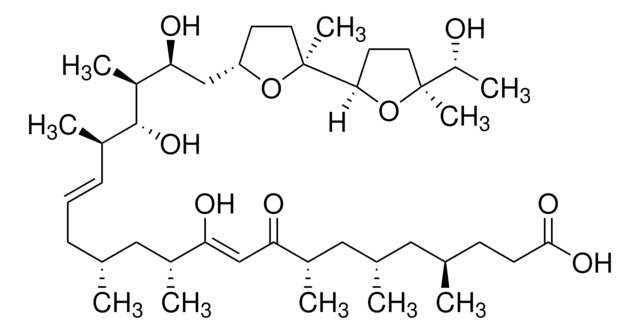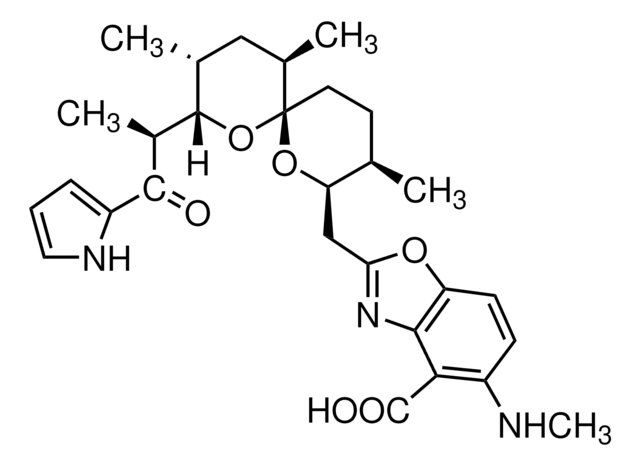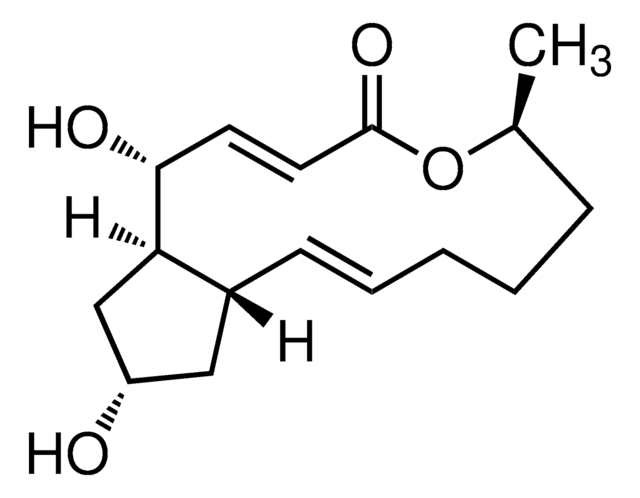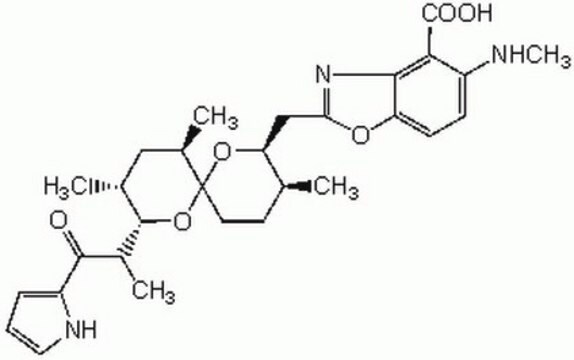I3909
Ionomycin calcium salt
Ready Made Solution, from Streptomyces conglobatus, 1 mM in DMSO
Sinonimo/i:
Calcium Ionophore Ionomycin
About This Item
Prodotti consigliati
Origine biologica
Streptomyces conglobatus
Livello qualitativo
Saggio
≥98% (HPLC)
Durata
2 yr
Condizioni di stoccaggio
(Tightly closed. )
Concentrazione
1 mM in DMSO
Colore
colorless
Punto di fusione
18.4 °C
Solubilità
DMSO: 1 mM
Spettro attività antibiotica
Gram-positive bacteria
Modalità d’azione
cell membrane | interferes
Condizioni di spedizione
wet ice
Temperatura di conservazione
−20°C
Stringa SMILE
C[C@@H]1CCC(=O)O[Ca]OC(=CC(=O)[C@@H](C)C[C@@H](C)C1)[C@H](C)C[C@H](C)C\C=C\[C@@H](C)[C@@H](O)[C@@H](C)[C@@H](O)C[C@@H]2CC[C@](C)(O2)[C@H]3CC[C@](C)(O3)[C@@H](C)O
InChI
1S/C41H72O9.Ca/c1-25(21-29(5)34(43)24-35(44)30(6)22-27(3)20-26(2)14-15-38(46)47)12-11-13-28(4)39(48)31(7)36(45)23-33-16-18-41(10,49-33)37-17-19-40(9,50-37)32(8)42;/h11,13,24-33,36-37,39,42-43,45,48H,12,14-23H2,1-10H3,(H,46,47);/q;+2/p-2/b13-11+,34-24-;/t25-,26-,27+,28-,29-,30+,31+,32-,33+,36+,37-,39-,40+,41+;/m1./s1
WKRWUYKLUMMAKG-WYGBAUISSA-L
Descrizione generale
Ionomycin is commonly used in cell biology experiments to induce a rapid and controlled increase in intracellular calcium levels. This allows to study the downstream effects of calcium signaling pathways, such as the activation of enzymes, the release of hormones, and the changes in gene expression.Ionomycin is also used to investigate the role of calcium in specific cellular processes, such as cell death, immune cell activation, and muscle contraction. For example, ionomycin can be used to induce apoptosis in cancer cells, study the activation of T cells, and investigate the role of calcium in muscle contraction.
Applicazioni
- Study of calcium signaling and its role in various biological processes
- Investigation of intracellular calcium levels, calcium-dependent enzymes, and cellular responses triggered by calcium influx
- Induction of a rapid and controlled increase in intracellular calcium levels in cell biology experiments
- Elucidation of specific cellular mechanisms and signaling pathways in combination with other substances, such as fluorescent calcium indicators or protein kinase activators
- to induce central demyelination
- inhibit adrenal bovine TREK-1 channels
- to regulate cell division of mature human B cells
Azioni biochim/fisiol
Mode of Action: Facilitates the transfer of calcium ions (Ca2+) across biological membranes
Antimicrobial Spectrum: Active against Gram-Positive bacteria
Caratteristiche e vantaggi
- Ready available solution reduce the need for preparation time
- Efficient choice for studying calcium signaling and its role in various biological processes
- Allows for rapid and controlled manipulation of intracellular calcium levels
- Versatile and widely used in cell biology research
Altre note
Codice della classe di stoccaggio
10 - Combustible liquids
Classe di pericolosità dell'acqua (WGK)
WGK 1
Punto d’infiammabilità (°F)
188.6 °F - closed cup
Punto d’infiammabilità (°C)
87 °C - closed cup
Dispositivi di protezione individuale
Eyeshields, Gloves, multi-purpose combination respirator cartridge (US)
Scegli una delle versioni più recenti:
Possiedi già questo prodotto?
I documenti relativi ai prodotti acquistati recentemente sono disponibili nell’Archivio dei documenti.
I clienti hanno visto anche
Il team dei nostri ricercatori vanta grande esperienza in tutte le aree della ricerca quali Life Science, scienza dei materiali, sintesi chimica, cromatografia, discipline analitiche, ecc..
Contatta l'Assistenza Tecnica.








